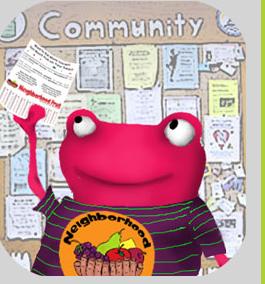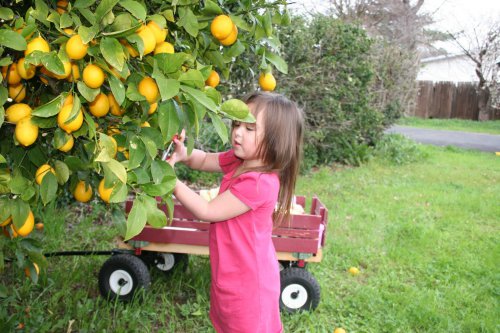Fruit trees have this annoying habit of not being regular and consistent with their yields. Even the most dedicated canners, preservers and jam-makers can experience fruit-overload. And what is more painful than seeing laden fruit trees in parks and other public areas, their abundance unappreciated?
Oriana Sarac and Kaytea Petro founded Neighborhood Fruit in 2009 to help keep fresh, local fruit from going to waste while encouraging neighbors to meet each other to share their pursuit of fruit. The website, with accompanying iPhone app, is designed to allow people to share excess fruit from their gardens, and search for local fruit trees in parks or along roads. Shareable talked to Oriana and Kaytea about their vision.
How did Neighborhood Fruit get started?
Kaytea: The seeds for Neighborhood Fruit started in two very disparate neighborhoods – a tree lined street in Sarajevo’s downtown in the former Yugoslavia, and a foggy residential San Francisco neighborhood – childhood homes of the two founders. Although the neighborhoods were continents apart, neighbors in each shared their abundance. Fast forward 25 years, Oriana and I met at a sustainable MBA program. When the time came to select a master’s thesis, the desire for my neighbor’s apples inspired me to explore localized produce sharing business models.
Oriana: Our backgrounds of growing up in sharing communities provided the initial inspiration; the unanticipated excitement and support received from all the stakeholders – major media, early adopters, partners, friends, family and users nationwide – sealed the idea into commitment.
What change do you want to make in the world with Neighborhood Fruit?
Kaytea: Making it more liveable by facilitating closer-knit communities through sharing is the grand vision of Neighborhood Fruit. Through Neighborhood Fruit's activities, we already are reducing the cost of food, minimizing the "carbon-food-mile", and bringing communities together; we aim to increase these activities.
Oriana: Edible urban forests accessible by all, regardless of socio-economic level, is what really gets me excited about this project.
What have you learned about sharing along the way?
Kaytea: (laughs) I've learned that I'm totally terrified to ring people's doorbells and ask them for some of the fruit I see sticking over the fence, which is ironic because I’m an extrovert. For me it's much easier to be the giver than the recipient.
Oriana: Everyone loves fruit! My favorite question is “What is your favorite fruit?” People always have passionate answers. What's your strategy to encourage people to share?
What is your strategy to encourage people to share?
Oriana: It doesn’t take much to encourage people to share; people are motivated to avoid waste. Once they find out we exist, they sign up.
Kaytea: Neighborhood Fruit was designed through a collaborative design process involving almost a thousand participants. Based on their feedback, we designed the NF services to empower the fruit givers as much as possible.
Tell us about your new iPhone app.
Oriana: Both of us use the Find Fruit iPhone app daily to locate fruit trees wherever we go. It’s always surprising to find a new tree near a favorite café. It’s a daily urban adventure!
Kaytea: I had a lot of fun researching and learning about all the fruit types. Did you know that Hackberries have been the same since the Miocene Era? We can eat the same thing as the dinosaurs!
Oriana: We currently have information on fruit trees in over 20 cities – the Bay Area, Los Angeles, San Diego, Seattle, Portland, Austin, etc. – and more get added all the time.

Shareable: I downloaded the iPhone app and tried to Find Fruit! in my neighborhood. I discovered several loquat trees in season. Luckily, the app's Fruit Information tab told me all about loquats so I didn't have to expose my ignorance, along with a picture of the ripe fruit and details on its growing season. The app worked beautifully.
Can you share a story about an interesting use of NF? Or something unexpected that has happened due to your service?
Oriana: We were pleasantly surprised by the fact that we were in the New York Times the week we launched the site in Beta. We had dreamed of major media coverage, but to get it so fast was a total surprise.
Kaytea: We’re really surprised by the amount of widespread acceptance Neighborhood Fruit has received. We knew we were into the idea of urban harvest, but we had no concept that everyone we talked to would love it too! We were afraid that we would appeal to only to Left Coast hippy types; it has been surprising the amount of support we’ve gotten from Florida grandmothers, Midwest home-school moms, and Brooklyn hipsters!
How prevalent are residential fruit trees in the United States? Do you have any idea about the potential size of this food source?
Kaytea: Neighborhood Fruit uses 80 million pounds of fruit as the conservative estimate of how much fruit is available from people's back yards. On public land, we estimate that between 5-15% of trees are potentially fruit bearing, adding an additional 120 million pounds of bounty.
What are Neighborhood Fruit’s growth plans for the future?
Kaytea: Over the past year, we have been approached by numerous community gleaning groups that need a set of tools to manage their harvest, volunteer, donor and recipient data. We are currently exploring funding options to be able to build it for them free of charge.
How can the Shareable community help Neighborhood Fruit?
Oriana: Please spread the word about Neighborhood Fruit and let your friends know about it. You can register your trees and share your fruit. If you know of a tree on public land, register it! We appreciate the ongoing support from the community. Without everyone’s help, Neighborhood Fruit would not be where it is today.
Neighborhood Fruit will be at at Maker Faire this weekend in San Mateo, CA; Shareable will be there too, at the Rentalic.com booth.









